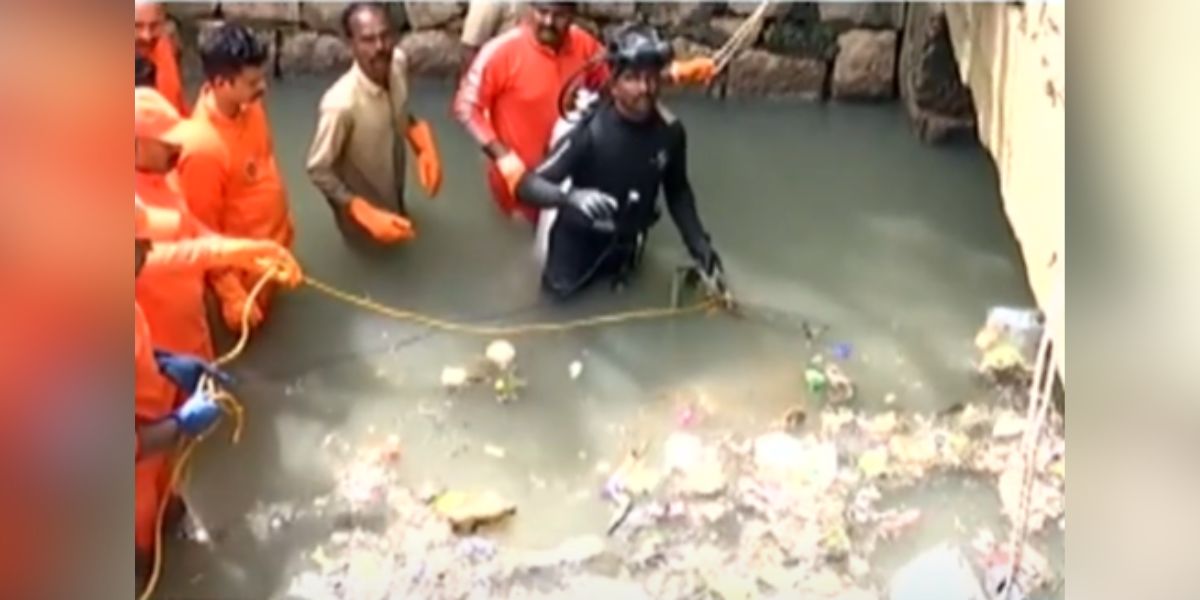The body of a sanitation worker, Joy, was recovered from the canal after a 46-hour-long search. He was cleaning the Amayizhanchan Thodu.
Published Jul 16, 2024 | 9:00 AM ⚊ Updated Jul 18, 2024 | 1:42 AM

Fire and rescue officials attempting to rescue Joy.
Kerala Labour Minister V Shivankutty, on Monday, 15 July wrote to the Union Railway Minister seeking compensation for the family of Joy, who died while cleaning the Amayizhanchan Thodu in Thiruvananthapuram’s Thampanoor.
The minister had earlier alleged that it was because of the lackadaisical attitude of the Thiruvananthapuram Railway Division that Joy lost his life. According to him, repeated requests from the government and the district Corporation to clean that part of the Amayazhinchan Thodu, that came under the Indian Railways, fell on deaf ears.
Meanwhile, the Kerala High Court has directed the Railways, Trivandrum Corporation, and Trivandrum Collector to submit reports on the flow of plastic waste into the Aamayizhanchan canal, its removal, and the parties responsible for it.
The reports, due on or before 26 July, have to outline the plan to remove existing plastic and legacy waste from the canal. This development comes after the body of a missing sanitation worker, Joy, was recovered from the canal after a 46-hour-long search.
The High Court bench, comprising Justices Bechu Kurian Thomas and Gopinath P, held a special sitting to address the issue on 15 July.
The Amicus Curiae will visit the incident site and other areas along the canal where waste has accumulated and interact with authorities involved in ‘Operation Anantha’ to gather insights on preventing such incidents in the future.
The court’s intervention aims to tackle the long-standing issue of plastic waste in the Aamayizhanchan canal and ensure measures are taken to prevent similar tragedies.
Railways, under fire over a sanitation worker’s death, offered an explanation: “Railway authorities have come under scrutiny after a sanitation worker, Joy, lost his life while cleaning the Aamayizhanchan canal. The tragic incident has raised questions about the Railways’ role in allowing plastic waste to clog the canal.”
With several people pointing at the Railways for its alleged negligence, the authorities have come out with an explanation. According to them, the Aamayizhanjaan Thodu canal, owned by the Irrigation Department, runs beneath the Thiruvananthapuram Central Railway station yard for 117 meters, connecting Thampanoor and Power House Road.
Despite the canal being under the primary maintenance of the Irrigation Department, Railways had undertaken the cleaning efforts.
The Railways stated that, as per the letters from the Secretary, Thiruvananthapuram Corporation dated 19 June this year, Railways have entrusted a contractor to clear the waste from the railway Portion of Amayizhanchan thodu.
“A tragic incident took place at around 11.15 am on 13 July at TVC. Joy who was engaged by M/s Biju for cleaning of
Amayizhanchan thodu at entry point near parcel siding of TVC station slipped and drowned. Joy was reportedly proficient in the work. The depth of water was about four feet. It is reported that, while he was assessing the feasibility of carrying out cleaning activities, there was a sudden increase in flow of water, due to rains. He slipped and couldn’t get up,” reads an excerpt from the explanation.
It further added, ” The root of the incident is piling of garbage in the Amayizhanchan thodu. The portion beneath the yard
– for about 117 m – has filth and garbage flowing through the Amayizhanchan thodu. There is indiscriminate disposal of garbage in the canal in the corporation area.”
While highlighting that Railways have a system of waste disposal in place, it also added that waste generated during passenger handling are properly taken away from the station.
“Thus the possibility of dumping of Railway waste in the canal is not there. Further, it is also worth mentioning here that, all the coaches running in Indian Railways are fitted with bio-toilets. This prevents open discharge of waste materials,” stated the Railways.
The Thiruvananthapuram Division also highlighted the presence of a natural barrier at the exit of the Amayizhanchan thodu from the railway yard. “Bed slope of the railway bridge is steeper so flood water is able to negotiate with a higher velocity whereas the bed slope beyond the road bridge at East fort road is flatter . This restricts and slows down the flow, causing collection of garbage and silt inside the covered/underground tunnel,” the statement said.
According to the division, this needs to be rectified to ensure free flow and preventing collection of garbage and preventing flooding of the station, railway track and nearby areas including the bus station.
“Due to the constraints of higher height at exit of yard, as mentioned above, the full advantage could not be, perhaps achieved and collection of waste has again happened. The work of cleaning the particular stretch has also been
planned by Irrigation department as can be seen from the report on flood mitigation works of June 2021,” pointed out the Railways.
(Edited by Neena with inputs from Dileep V Kumar)
(South First is now on WhatsApp and Telegram)
